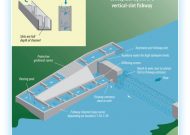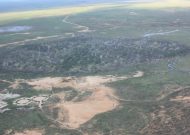Noonamah Water Scheme
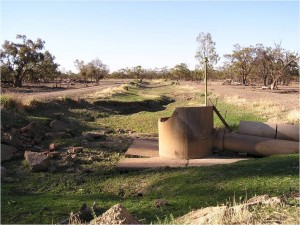
Example of decommissioned Noonamah Water Scheme channel frog habitat (Image: Norman Wise, NoW, November 2012)
Surveys conducted by Charles Sturt University (CSU) detected the presence of the endangered species Litoria raniformis, the Southern Bell Frog, at Lake Bullogal in the Lower Lachlan Swamp in November 2012 (Amos et al., 2013). Litoria raniformis was previously recorded near Oxley in 1972 and in the Booligal wetlands in 1978 (Wassens, 2008). Prior to the flood inundation of 2012 Lake Bullogal had not held water since the early 1990s. As the Southern Bell Frog requires areas of permanent water throughout the year, its occurrence at Lake Bullogal may be linked to the Noonamah stock channel which, until the piping of the scheme in 2012, had received each year at least one flow of water in spring which would run the channels and top up the dams. The recent completion of the project to pipe the scheme means that the 2013/14 summer will be the first since the scheme’s inception that will not see a flow along the channel or a replenishment of water levels in the dams nearest to Lake Bullogal. A key objective of this flow is to maintain a potential critical refuge site of Southern Bell Frog in the Lachlan valley.
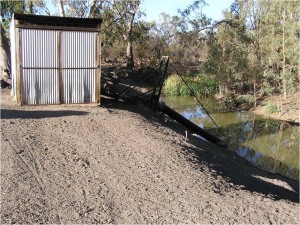
Landholder pump house and shallow water habitat of the channels (Image: Norman Wise, NoW, November 2012)
The action is to provide up to 300 ML of environmental water to the old Noonamah Water Scheme via a private landholder’s works. The key objective is to provide habitat for the recently discovered Southern Bell Frog population. This proposal aims to provide sufficient water via the original Noonamah Water Scheme pump to inundate the 13.5 km of channel and 5 dams/ground tanks closest to Lake Bullogal. As the channel is no longer required for stock water delivery to other properties further out on the scheme it is possible to block the channel at agreed points on Noonamah so as to hold the water within the targeted area of channel and dams. Water for this event is being provided from a HS licence provided to NSW Office of Environment and Heritage as a result of water savings made from the piping scheme which replaced the previous works.
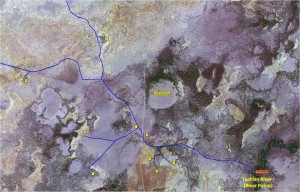
Image of first section of open earth channels which start and spread out from the Lachlan River (far right) (Image: NoW)
To date all the targeted ground tanks nearest to Lake Bullogal and the associated 13 km of channel (as indicated on the map to the left) have been filled requiring only 65 ML of water to be delivered via the pump.
In tandem with the environmental flow, CSU has been contracted to undertake targeted surveys for Southern Bell Frog and other frog activity which may be triggered by the delivery of the wateralong the channel and into the dams. This study will help identify the refuge habitat value for Southern Bell Frogs of the old Noonamah Water Scheme channel and dams in the vicinity of Lake Bullogal.
Lower Lachlan Noonamah Water Authority Stock & Domestic Pipeline (Pipeline NSW Program)
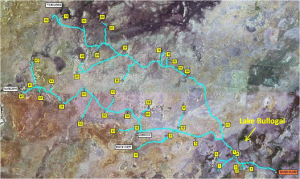
Map of the Noonamah Water Scheme dams (yellow boxes) and open earth channels (aqua lines) (Source: Figure 9 in NSW Office of Water 2013)
The ‘old’ Noonamah Water Scheme utilised some 150 km of channels to fill 43 farm dams, as illustrated in the maps to the left of this text. Under the Pipeline NSW Program, the Noonamah Water Scheme system of open earth channels, which delivered stock & domestic water into farm dams for rural landholders and primary producers, was replaced with efficient small diameter pipelines, tanks and troughs to provide landholders with a more secure and better quality water supply for stock and domestic use. The ‘Lower Lachlan Noonamah Water Authority Stock & Domestic Pipeline’ (Pipeline hereafter) project ran from September 2011 to March 2013, and comprises ~ 115 km of pipe and savings of 795 ML/year. This water saved was reallocated and is managed for environmental purposes according to the Lachlan Adaptive Environmental Water use plan (approved 7th September 2012), and will be used from Booligal Weir to benefit the river where the savings were created.
Most of this information and further details is available in the NSW Office of Water’s (2013) ‘Pipeline NSW Project Final Report’, which also lists some of the environmental benefits of the project including water efficiency gains.

